⚠️ Notice on U.S. Shipments: Due to recently implemented tariffs, shipments to the U.S. may experience longer than usual delays and/or increased import charges.
Menu
-
- Sedans & Hatchbacks
- Small Crossovers (CUVs)
- Large Crossovers (SUVs)
- Sports Cars
-
Other Models
-
Wheels & Tires
- Lifestyle
-
Detailing
- Mazda Added Protection
-
- 1-833-509-1460
- Login
-
United States (USD $)

⚠️ Notice on U.S. Shipments: Due to recently implemented tariffs, shipments to the U.S. may experience longer than usual delays and/or increased import charges.
Sedans & Hatchbacks
Small Crossovers (CUVs)
Large Crossovers (SUVs)
Sports Cars
What is SKYACTIV anyways? Part 1: The heart of SKYACTIV.
October 30, 2018 5 min read
It's everywhere. You hear and see it everywhere, and your Mazda might even have it! SKYACTIV isn't a new concept either, because Mazda introduced it into its line of products back in 2011. Now the revolutionary, next-generation SKYACTIV-X Engine (the Holy Grail of Gasoline Engine) is the newest breakthrough for Mazda. But, today we are not going to talk about the SKYACTIV-X Engine, instead, let's go back to the basics of SKYACTIV.
So, what is "SKYACTIV" anyways?
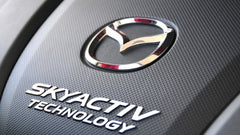
SKYACTIV is a series of technologies designed and developed by Mazda to create a unique sense of oneness on the road - between vehicle and driver. With each SKYACTIV component working seamlessly together, you'll enjoy superior fuel economy, enhanced safety, and lower emissions.
Designed together as part of the whole vision, this is what makes up SKYACTIV:
- Engines - Gasoline and Diesel
- Transmissions - Automatic and Manual
- Body
- Chassis
Mazda's passion is rooted in crafting vehicles that account for human thoughts, feelings, and emotions in the design process while delivering spirited, stylish and insightful vehicles.

The internal combustion engine is actually very inefficient. In theory, only 30% of the energy is used in the gasoline, meaning 70% of it is wasted. So Mazda's team of innovative engineers went to the drawing board and focused on optimizing the efficiency of the engine, and getting more energy out of the fuel. Starting with the heart and soul of your Mazda, the SKYACTIV-G engine has been developed to produce more low/mid-range torque, but with lower fuel consumption and emissions than previous gasoline engines. The result? A 15% increase in fuel efficiency and torque!
How do they accomplish this?
Though Combustion Enhancement and Friction Reduction.
- A high 13:1 compression ratio
- High-pressure 6-hole direct fuel injector
- Unique 4-2-1 exhaust manifold
- Shorter combustion duration
For those who are not too familiar with the four-stroke engine, here is a quick rundown of the basics:

1. Air intake 2. Compress the air 3. Ignite the air/fuel mixture for combustion 4. Exhaust gases leave the chamber
Firstly, Mazda's SKYACTIV engines run a high 13:1 compression ratio as compared to a conventional engine which has a 10:1 ratio (compression ratio is the ratio of the maximum cylinder volume when the piston is at the bottom, compared to the minimum cylinder volume when the piston is at the top). A high compression ratio helps yield better efficiency and better performance. But why does compression ratio matter?
 In this example, the compression ratio is 14:1 because the maximum cylinder volume is 14cc, and the minimum cylinder volume is 1cc.
In this example, the compression ratio is 14:1 because the maximum cylinder volume is 14cc, and the minimum cylinder volume is 1cc.
Having a higher compression ratio (a bigger ratio = greater compression, and a higher compression of the air in the chamber will result in a more powerful explosion from the air-fuel mixture). In short, with a higher compression ratio, the engine is getting more work out of the same amount of fuel, which is good for power and getting better fuel economy.
To increase the compression ratio, Mazda placed a dome shape on each piston - this way, the more you squeeze the air-fuel mixture, the more energy you get from the combustion. 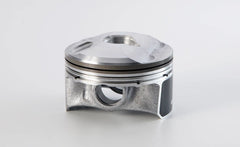
The top of this piston is shaped like a dome. Also, notice the cavity on the top.
But, having a high compression ratio increases the chance of engine knock (the result of high pressure and excess heat in the chamber, causing for the air-fuel mixture to ignite too soon on its own - leading to damage to your engine). In order to prevent this from happening, Mazda created some innovative solutions to lower the temperature of the air-fuel mixture.
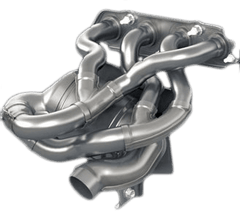 Mazda's 4-2-1 Exhaust Manifold. (Why is it called 4-2-1? Look how it starts with 4 exhaust pipes, and they merge to make 2 pipes, then merges to make 1 pipe)
Mazda's 4-2-1 Exhaust Manifold. (Why is it called 4-2-1? Look how it starts with 4 exhaust pipes, and they merge to make 2 pipes, then merges to make 1 pipe)
In order to get the hot exhaust gases out (the last step in the 4-stroke engine), Mazda adopted a 4-2-1 exhaust system in order to reduce the amount of hot residual gas in the cylinder.
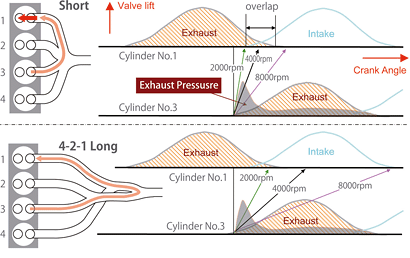 The exhaust pressure difference between 4-1 vs a 4-2-1 exhaust manifold.
The exhaust pressure difference between 4-1 vs a 4-2-1 exhaust manifold.
Conventional systems use a 4-1 exhaust manifold, as it is the shortest way to get the hot exhaust gases to the catalytic converter. (Catalytic converters converts toxic gases and pollutants from the exhaust gas in order to reduce emissions. How? Through chemistry reactions to further break down the toxic gases). But with a 4-2-1 exhaust, it lengthens the distance for the exhaust gases to travel. The back pressure wave isn't as strong which significantly reduces the temperature in the combustion chamber because there is less of the hot exhaust gases going back into the chamber.
 Mazda's 6-hole direct fuel injector fires gasoline into cylinders at high pressures.
Mazda's 6-hole direct fuel injector fires gasoline into cylinders at high pressures.
Mazda's engineers also implemented a high pressure, 6-hole direct fuel injector that fires gasoline into the cylinder at 3000psi, to produce an evener air-fuel mixture (better atomization means maximizing the combustion process), and to lower the temperature inside the cylinder. Additionally, they designed a piston cavity to help accelerate the combustion speed, drastically improving the combustion process.
In the newer generation models with the upgraded SKYACTIV-G engines, the fuel injector pressure is 50% higher causing for reduced emissions and fuel consumption as a result of superior combustion. When the engine is cold, the fuel is injected in 3 small bursts rather than 1 spray. This 3 stage split helps improve vaporization and atomization of fuel and reduces soot (residue of unburned fuel) by 80% during cold weather operation.
Cylinder Deactivation is also available in 2.5L engines on select models. In light-load driving situations, such as cruising on the highway, Mazda's engine will shut down 2 of the cylinders in order to save fuel.
Mazda's SKYACTIV-G 2.5 T is the first turbocharged engine which provides exceptional acceleration performance. There is a water jacket spacer inside the engine block which helps reduce heat loss to the coolant, improving both fuel efficiency, environmental performance and stabilizes the combustion at all rpm ranges. 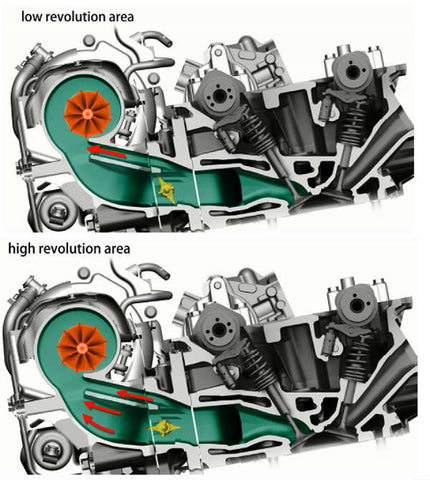 Mazda's Dynamic Pressure Turbo
Mazda's Dynamic Pressure Turbo
To solve the turbo-lag problem, Mazda's Dynamic Pressure Turbo closes a series of valves right before the turbine at low rpms. With improved efficiency due to the 4-3-1 exhaust manifold, Mazda is able to extract the full potential of the turbo system - producing a linear response with great amout of torque at all rpm ranges.
Mazda's innovative engineers' reimagined and reinvented the combustion process to create the SKYACTIV engine. With their immense attention to detail and their persistent passion for driving and innovation, Mazda has infused the soul of motion into SKYACTIV Technology to bring us the joy of driving.
Stay tuned to learn about the other parts that make up SKYACTIV Technology!















